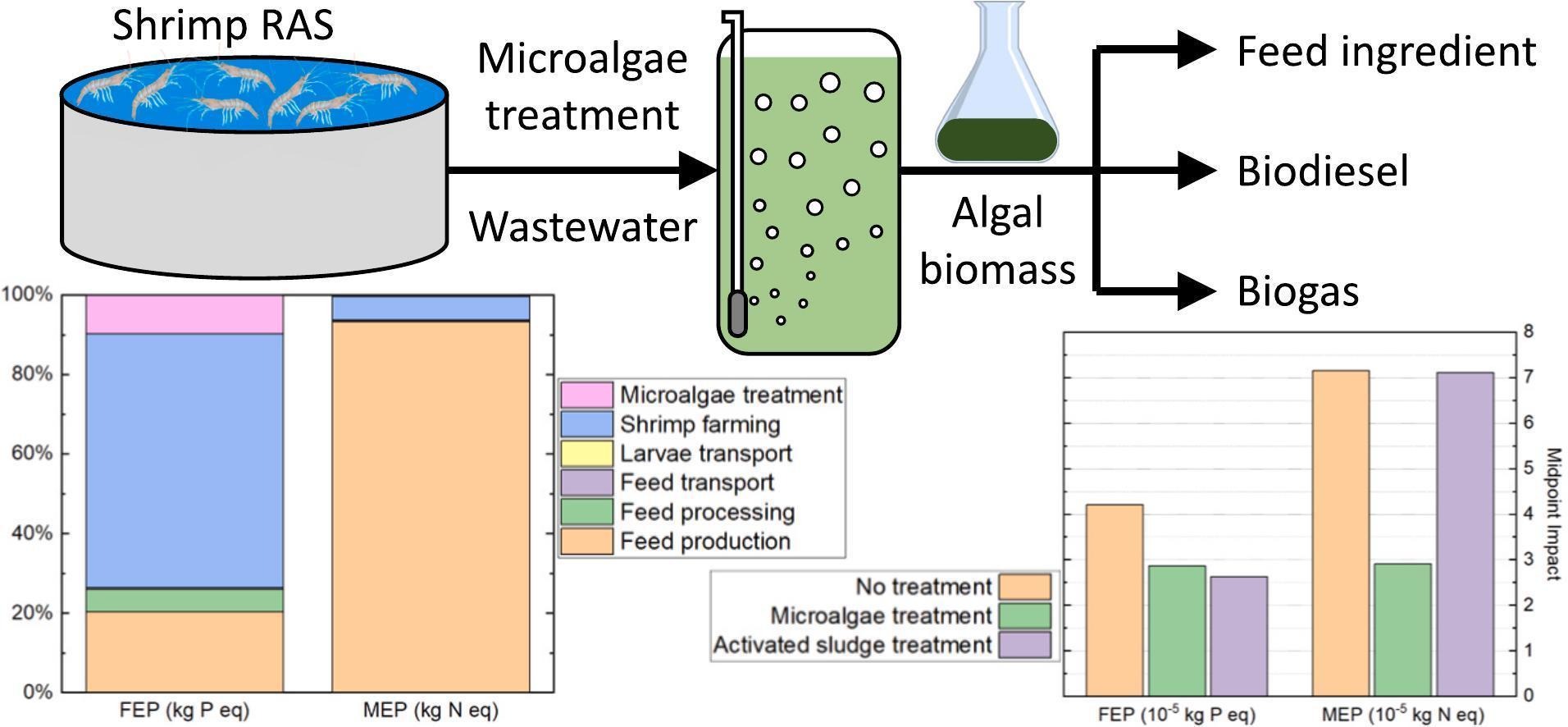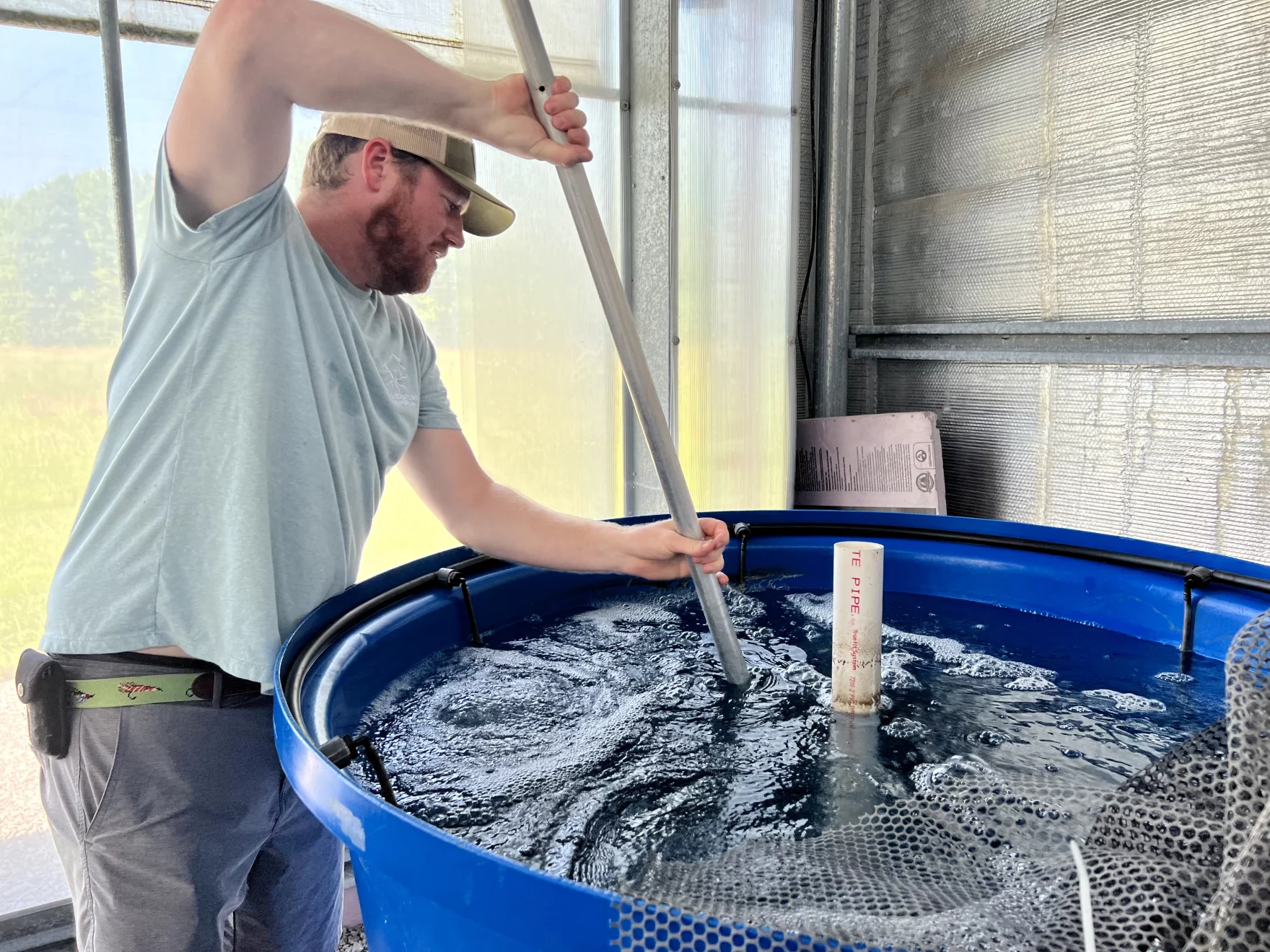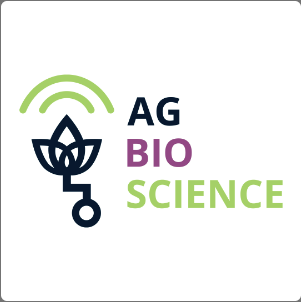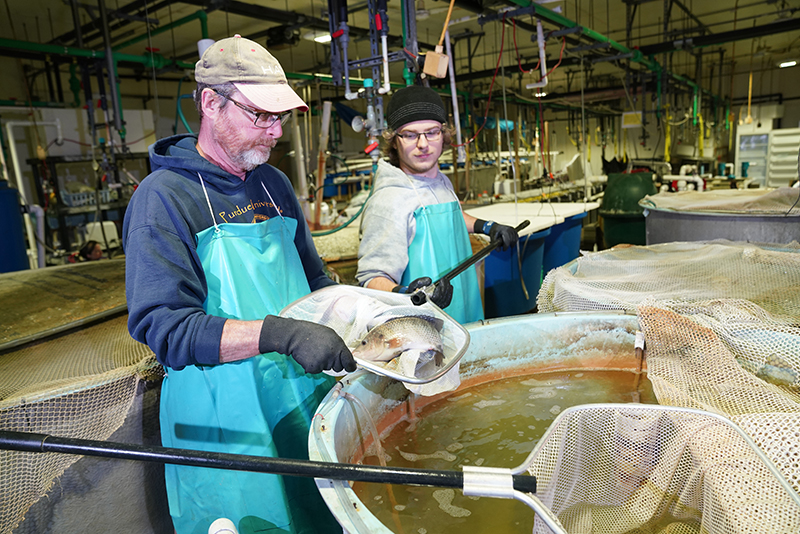NEWS
Published Works
Abstract
Fish stocking density is a key factor in aquaponics, affecting nutrient availability, water quality, and overall system productivity. While research has focused on improving productivity, the potential inclusion of microalgae as an additional subsystem remains largely underexplored. Microalgae offer added benefits, including nutrient recovery, water quality improvement, and production of high-value biomass. This study evaluated the effects of varying tilapia (Oreochromis niloticus) stocking densities (10, 20, 30, and 40 kg m−3) on the production and nutritional composition of Chlorella vulgaris and lettuce (Lactuca sativa cv. Muir) in a partially decoupled aquaponics system. Higher stocking densities (30–40 kg m−3) resulted in significantly higher fish biomass, lettuce yield, and algal biomass. Increased fish stocking densities resulted in higher nutrient concentrations leading to higher plant growth and algal productivity. C. vulgaris cultivated at higher stocking densities exhibited increased crude protein concentration and a more favorable essential amino acid profile, particularly for lysine and methionine. However, a trade-off was observed as higher stocking densities led to a reduction in crude fat and certain fatty acids, including stearic and oleic acid. The findings indicate that stocking density and the resulting nutrient flows through subsystems influence algal nutrient concentrations, which can be strategically managed to optimize algal composition, with higher densities favoring protein-enhanced biomass and lower densities supporting lipid accumulation. This study highlights the potential of integrating algae as a value-added subsystem in aquaponics to enhance productivity and diversify outputs. Read more here!
Abstract
Algae are promising renewable energy sources for biofuel production but remain cost-bottlenecked by lipid extraction. A low-energy solution could be provided by viral lysis by PBCV-1, a Chlorella-specific lytic virus that occurs widely in the natural environment. PBCV-1 can lyse host cells and release the intracellular lipids without using expensive sonication or chemicals. Although its capacity for disruption is documented, limited information is available on how it might rewire the host’s lipidome before lysis. The objective of this study was to investigate triacylglycerol (TAG) accumulation profiles in Chlorella infected with PBCV-1. A high-resolution epifluorescence microscopy approach was employed to analyze over 4,000 cells across a full PBCV-1 lytic cycle to monitor TAG accumulation, chlorophyll fluorescence, and nuclear morphology. A multivariate unsupervised machine learning analysis revealed infection-driven asynchronous phenotypic trajectories with a 165.2 % relative increase in TAG fluorescence, contrasting with a negligible lipid gain of 5.1 % in uninfected cells. This virus-induced lipid enrichment approach has generated TAGs at levels typically achieved through nutrient deprivation, salt stress, or other synthetic or cultivation stress induction techniques. Extracellular nitrate and phosphate were further analyzed with ion chromatography under nutrient-replete conditions (NO3–-N > 50 mg L-1, PO43--P > 65 mg L-1) to exclude the confounding factors of nutrient stress on lipid accumulation. The results demonstrated that PBCV-1 is a metabolic modulator and enhances TAG reserves intracellularly before facilitating their release. This study provides a novel biomimetic approach to accumulate and extract algal lipids for cost-effective biofuel production. Read more HERE!
Abstract
Aquaculture sludge (AS), rich in nutrients, can pose environmental risks such as eutrophication, threatening aquatic ecosystems and water quality if not properly managed. However, AS can also be used as a feedstock for bioenergy production. This study investigated bioenergy (methane) production from AS and dairy manure (DM) under anaerobic codigestion using the biochemical methane potential test. Results showed that anaerobic codigestion of DM and AS produced higher methane production compared with their individual monodigestion. The DM:AS ratios of 50:50, 30:70, and 10:90 showed synergistic effects, with codigestion performance indices of 1.2, 1.3, and 1.5, respectively. A DM:AS ratio of 10:90 provided the highest methane production of 341.80 mL g−1 volatile solids, being 65% and 52% greater than those from monodigestion of these two feedstocks, respectively. A hydraulic retention time of 16 days was found optimum, attaining 90% of the cumulative methane production. The experimental data of methane production fitted perfectly with the superimposed model, reflecting contribution from both readily degradable and harder fractions of the feedstock mix. These findings present an approach to effective valorization and management of the nutrient-rich AS through enhanced energy recovery and promote sustainability in the aquaculture industry. Read more HERE!
Abstract
Algal biofuel is promising but challenged by balancing biomass productivity (BP) and lipid content (LC) to achieve high lipid productivity (LP). The aim of this study was to develop a novel machine learning (ML) approach to model complex nonlinear relationships between cultivation conditions and LP in Chlorella species. We created a database of 38 cultivation variables from over 300 algal growth scenarios (12,000+ data points) from peer-reviewed studies. These data were used to train the first ML random forest model to maximize LP. The newly developed RF-ML model was able to predict high LP (>0.018 g L−1 d−1) with an accuracy of 95.2 %. This approach offers a novel solution to a critical challenge and leads to a substantial reduction (by <96.7 %) in the broad operational ranges of algal cultivation conditions for improved LP, holding great promise for potential cost savings in algal cultivation. Our partial dependence plots (PDPs) identified exogenous iron and phosphorus as key drivers of high LP, challenging the longstanding focus on nitrogen starvation as the dominant lipid trigger strategy in the literature. This framework, at the core of artificial intelligence (AI), offers a promising avenue to boost algae lipid production for biodiesel through efficient, data-driven cultivation. Read more HERE!
Abstract
Aquaculture operations generate substantial wastewater containing organic matter, total dissolved solids, emerging contaminants, and uneaten food pellets, leading to significant environmental issues. In this study, electrooxidation (EO) treatment methods using a boron-doped diamond (BDD) electrode was employed to remove soluble chemical oxygen demand (sCOD), ammonia (NH3-N), nitrate (NO3−-N), nitrite (NO2−-N), total dissolved phosphorus (TDP), and total dissolved nitrogen (TDN) from aquaculture wastewater. Response surface methodology (RSM) was used to design experiments and optimize operating parameters. Read more here!

As a rapidly growing source of human nutrients, algae biosynthesize diverse metabolites which have promising bioactivities. However, the potential allergenicity of algal components hinder their widespread adoption. This review provides a comprehensive review of various macro and micronutrients derived from algal biomass, with particular focus on bioactive compounds, including peptides, polyphenols, carotenoids, omega-3 fatty acids and phycocyanins. The approaches used to produce algal bioactive compounds and their health benefits (antioxidant, antidiabetic, cardioprotective, anti-inflammatory and immunomodulatory) are summarised. This review particularly focuses on the state-of-the-art of precision fermentation, encapsulation, cold plasma, high-pressure processing, pulsed electric field, and subcritical water to reduce the allergenicity of algal compounds while increasing their bioactivity and bioavailability. By providing insights into current challenges of algae-derived compounds and opportunities for advancement, this review contributes to the ongoing discourse on maximizing their application potential in the food nutraceuticals, and pharmaceuticals industries.
Abstract
Shrimp production facilities produce large quantities of wastewater, which consists of organic and inorganic pollutants. High concentrations of these pollutants in shrimp wastewater cause serious environmental problems and, therefore, a method of treating this wastewater is an important research topic. This study investigated the impact of algae and indigenous bacteria on treating shrimp wastewater. A total of four different microalgae cultures, including Chlorococcum minutus, Porphyridum cruentum, Chlorella vulgaris and Chlorella reinhardtii along with two cyanobacterial cultures, Microcystis aeruginosa and Fishcherella muscicola were used with indigenous bacterial cultures to treat shrimp wastewater. The highest soluble chemical oxygen demand (sCOD) removal rate (95%) was observed in the samples that were incubated using F. muscicola. Total dissolved nitrogen was degraded >90% in the C. vulgaris, M. aeruginosa, and C. reinhardtii seeded samples. Dissolved organic nitrogen removal was significantly higher for C. vulgaris (93%) as compared to other treatments. Similarly, phosphate degradation was very successful for all the algae-bacteria consortium (>99%). Moreover, the degradation kinetics were calculated, and the lowest half-life (t1/2) for sCOD (5 days) was recorded for the samples seeded with M. aeruginosa. Similarly, treatment with F. muscicola and C. reinhardtii showed the lowest t1/2 of NH3–N (2.9 days) and phosphate (2.7 days) values. Overall, the results from this study suggest that the symbiotic relationship between indigenous bacteria and algae significantly enhanced the process of shrimp wastewater treatment within 21 days of incubation. The outcome of this study supports resource recovery in the aquaculture sector and could be beneficial to treat a large-scale shrimp facility's wastewater worldwide.

Abstract
The electrocoagulation (EC) and electrooxidation (EO) processes are employed widely as treatment processes for industrial, agricultural, and domestic wastewater. In the present study, EC, EO, and a combination of EC + EO were evaluated as methods of removing pollutants from shrimp aquaculture wastewater. Process parameters for electrochemical processes, including current density, pH, and operation time were studied, and response surface methodology was employed to determine the optimum condition for the treatment. The effectiveness of the combined EC + EO process was assessed by measuring the reduction of targeted pollutants, including dissolved inorganic nitrogen species, total dissolved nitrogen (TDN), phosphate, and soluble chemical oxygen demand (sCOD). Using EC + EO process, more than 87% reduction was achieved for inorganic nitrogen, TDN, and phosphate, while 76.2% reduction was achieved for sCOD. These results demonstrated that the combined EC + EO process provided better treatment performance in removing the pollutants from shrimp wastewater. The kinetic results suggested that the effects of pH, current density, and operation time were significant on the degradation process when using iron and aluminum electrodes. Comparatively, iron electrodes were effective at reducing the half-life (t1/2) of each of the pollutants in the samples. The application of the optimized process parameters on shrimp wastewater could be used for large-scale treatment in aquaculture.
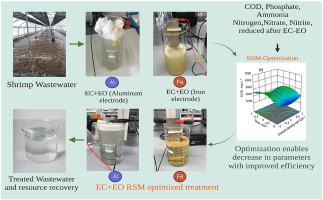
Abstract
Aquaculture is a controlled aquatic farming sector and one of the most important human food sources. Fish farming is one of the predominant, fast-growing sectors that supply seafood products worldwide. Along with its benefits, aquaculture practices can discharge large quantities of nutrients into the environment through non-treated or poorly treated wastewater. This study aims to understand the nutrient composition of fish wastewater and the use of indigenous bacteria, cyanobacteria, and microalgae as an alternative biological treatment method. Wastewater samples from a local fish farming facility were collected and treated using six different species of cyanobacteria and microalgae include Chroococcus minutus, Porphyridium cruentum, Chlorella vulgaris, Microcystis aeruginosa, Chlamydomonas reinhardtii, and Fischerella muscicola. All the samples were incubated for 21 days, and the following parameters were measured weekly: Chemical oxygen demand (COD), phosphate, total dissolved nitrogen, and dissolved inorganic nitrogen. In addition, dissolved organic nitrogen (DON), bioavailable DON (ABDON), and biodegradable DON (BDON) were calculated from the mass-balance equations. Colorimetric and digestive methods were used for the parameter measurements. The results showed that C. reinhardtii reduced the soluble COD concentration by 74.6 %, DON by 94.3 %, and phosphorous by more than 99 %. Moreover, M. aeruginosa, and C. minutus significantly reduced inorganic nitrogen species (>99 %). This alternative fish wastewater treatment method was explored to gain insight into fish wastewater nutrient composition and to create a sustainable alternative to conventional fish wastewater treatment methods.
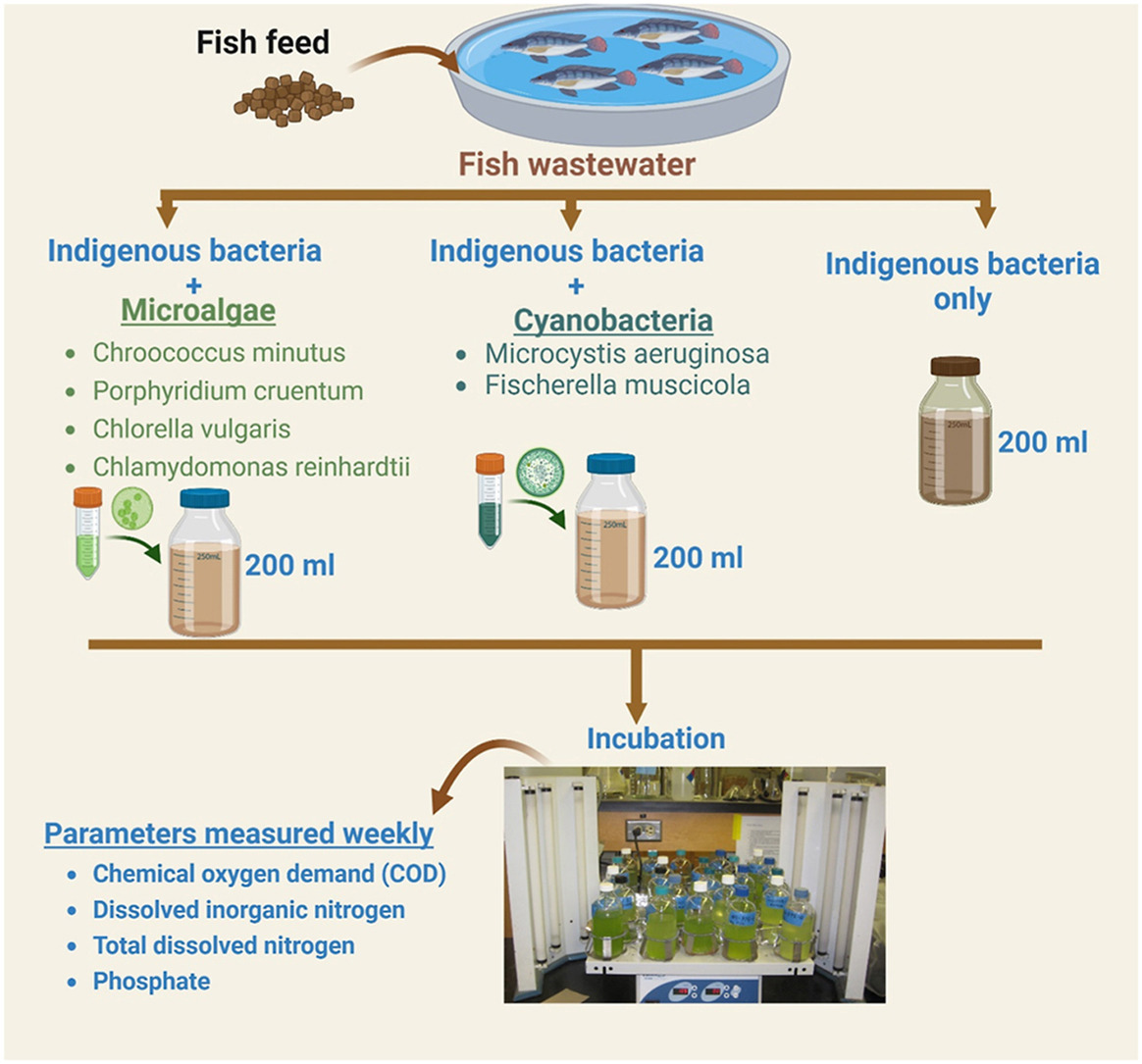
Abstract
Aquaponics is an integrated food production system that intensively produces a diverse array of seafood and specialty crops in one closed-loop system, which is a potential solution to global challenges of food security. While current aquaponics systems are commonly operated with freshwater, marine aquaponics is an emerging opportunity to grow saltwater animals and plants. Although marine aquaponics can reduce the dependence on freshwater for food production, its environmental sustainability has not been systematically studied. This paper presents the first life cycle assessment (LCA) on a marine aquaponic production system growing shrimp and three halophytes. The system assessed covered from shrimp larvae nursery to grow-out. The effects of salinity, carbon/nitrogen (C/N) ratio, and shrimp-to-plant stocking density ratio of aquaponics on its midpoint and endpoint environmental impacts were evaluated using a functional unit based on the economic value of the four products. Electricity use for aquaponic operation was the environmental hotspot, contributing ∼90 % to all the midpoint impacts. The system produced higher environmental impacts when operated at higher salinity, but lower C/N ratio and stocking density. Replacing fossil fuel with wind power for electricity generation can decrease the environmental impacts by 95–99 %. Variation in the shrimp price can change the impacts by up to 62 %. This study provides a useful tool to help marine aquaponic farmers improve their production from an environmental perspective and can serve as groundwork for further assessing more marine aquaponic systems with different animal-plant combinations.

